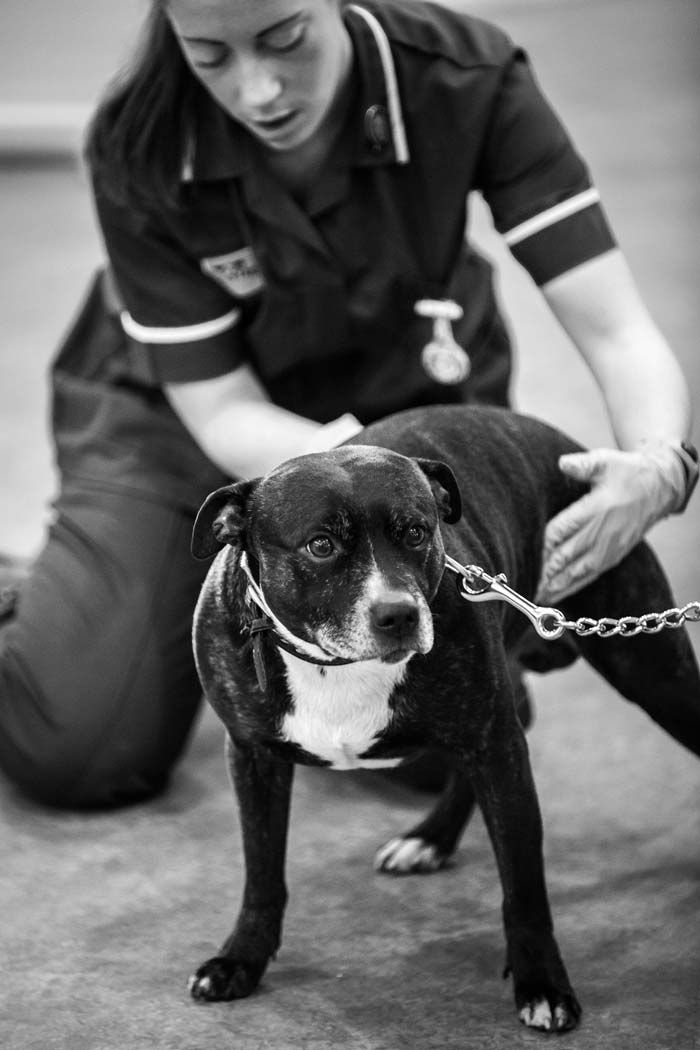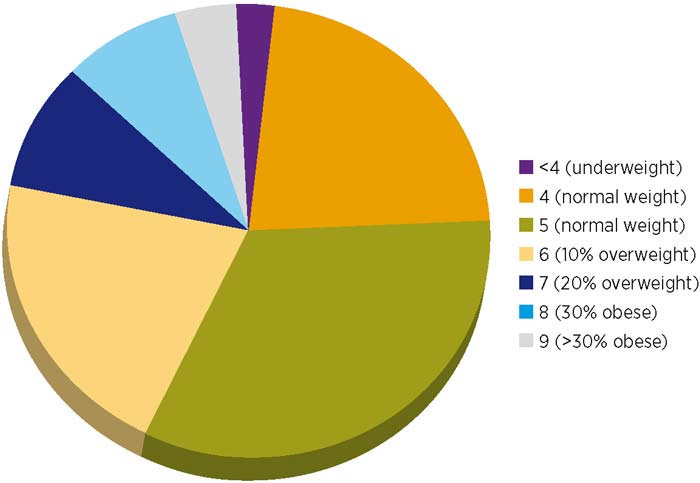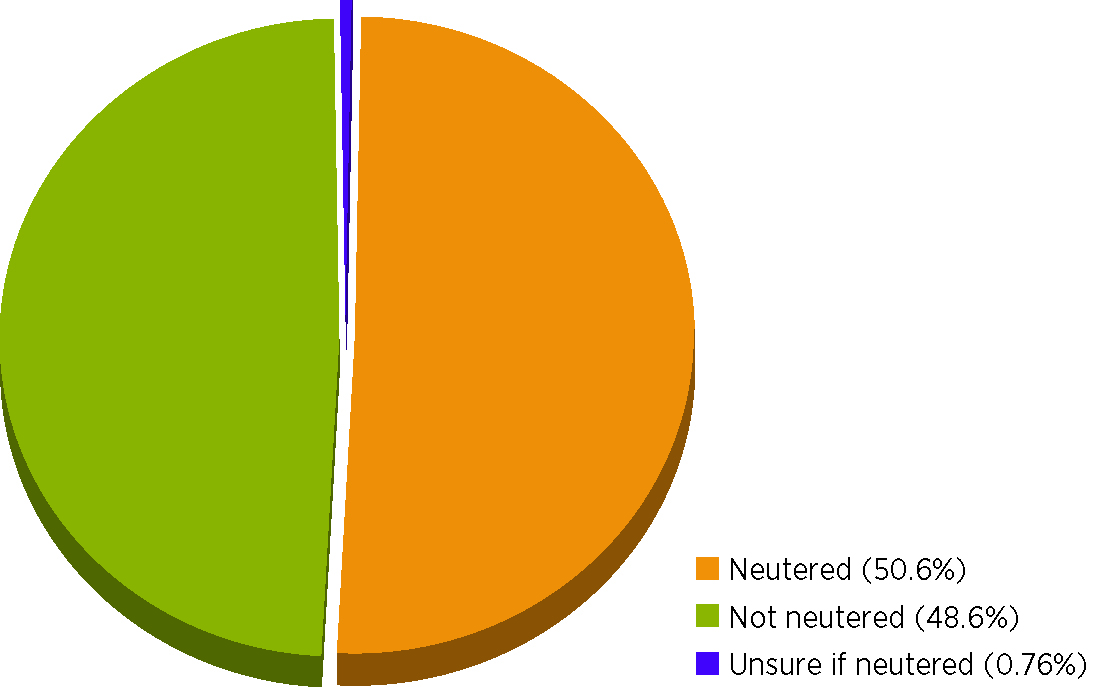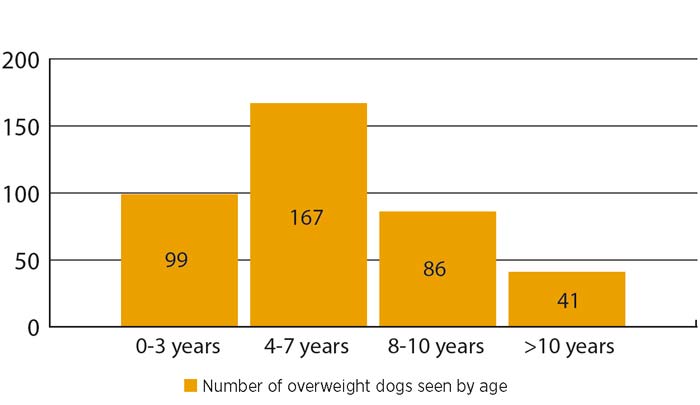1 Oct 2019
Clare Jones looks at dogs that have been health checked and body condition scored at local Dogs Trust events to determine whether certain factors contribute to them being overweight.

Pet obesity is a constantly growing concern within the veterinary profession. This paper looks at dogs that have been health checked and body condition scored at local Dogs Trust community events to collate statistics in this area of interest.
It aims to see what percentage of dogs seen in socially deprived areas are overweight and if their age, being neutered and if they regularly attend a veterinary clinic may have an effect on them being overweight.
Pet obesity is a constantly growing health concern within the veterinary industry, with 81% of vets and VNs reporting they have witnessed an increasing problem in a two-year period (Vets4Pets, 2016).
This paper will be focusing solely on obesity observed in dogs, of which the Pet Food Manufacturers’ Association (2017) has reported an estimated 8.5 million exist in the UK. Dogs are classified as overweight if they are 10% to 20% over their ideal weight and are regarded as obese when they are more than 20% above their optimum weight (Linder and Mueller, 2014).
Numerous published articles discuss the growing weight problem, all estimating the percentage of dogs believed to be overweight or obese. According to the Association of Pet Obesity Prevention, 20% of dogs are considered to be obese (Brown, 2015).
German (2006) wrote that a variety of studies had been done in various parts of the world that estimated obesity in dogs was between 22% and 40%. Holden (2013) estimated approximately 40% of dogs in the UK were overweight; however, Courcier et al (2010) estimated a huge 59% of dogs in the UK were overweight or obese.
The Kennel Club (2017) has estimated around 30% to 60% of dogs are overweight. If the estimated statistic of 8.5 million dogs in the UK is correct then a very worrying 2.5 million to 5.1 million dogs are overweight and/or obese.
The author was intrigued by these statistics, and wondered what studies had been done to obtain them and where? It is quite likely the data was taken from animals seen and assessed in veterinary clinics or referral centres – and, therefore, statistics taken from a small study out in the community could prove interesting.
The author works as a campaigns veterinary nurse for Dogs Trust throughout the north-west, visiting areas of social deprivation, providing free health checks and microchipping, and aiming to help improve the lives of the dogs in these areas. The areas attended are chosen due to the results of the stray dog survey and where any reported dog problems exist.
Many of the people who attend the events are unable to afford, or are unable to regularly visit, the vets with their dog and potentially represent a portion of the dog-owning population that may not have been sampled in the previous studies.
The author wished to discover if dogs were more or less likely to be overweight in areas where owners may not go regularly to the vets and, therefore, may not be receiving any guidance on their pet’s weight.
A number of reasons exist as to why dogs gain weight and these need to be assessed when talking to owners about their dogs’ (and their own) lifestyle.
Many owners will feed ad-lib without considering the need to determine if the amount is too much for their particular dog. Owners will often think if the dog is hungry it will eat, and if it isn’t it won’t, but do not realise – unlike (most) cats – dogs largely do not self-regulate their daily intake.
Many owners also said their dog got one or two cups of food a day; however, did not understand how much this equated to. If they have previously weighed and marked an amount in a cup, the general belief is this will be the same every time. However, this is a common misconception and it has been shown by using cups you can underfeed by 18% or overfeed by a staggering 80% (German, 2010).
Overfeeding a puppy will also increase the likelihood of an increased number of fat cells in the body, which could contribute to being overweight throughout its life (Royal Canin, 2015). Knowing the correct amount of food to feed is important – and, therefore, weighing the food at every meal using kitchen scales should be encouraged.
Owners may also be feeding their dogs unbalanced diets, which can be insufficient in the necessary nutrients, as well as high in fats and carbohydrates. Many of these foods may be being fed due to socioeconomic causes or the great abundance of diets on the market/being advertised making it very difficult to ascertain which one is the best to choose for an individual dog.
Killing with kindness is a phrase we all hear frequently and often many members of the family are blamed for this – for example, the children dropping food. Treats, scraps from plates and items that owners don’t realise are not suitable for dogs are actually highly calorific and play a big part in obesity.
Unfortunately, we all know many dogs get insufficient exercise, which can contribute greatly to weight gain. Many reasons may exist for this, such as the dog or owner having mobility problems or owners being unaware of the importance of exercise. Exercise is vital for not only weight loss, but also for the dog’s quality of life. The owner must ask for help if he or she is unable to provide his or her dog with this and, if limited, to provide alternative means of enrichment/stimulation.
After a dog has been neutered a need exists to reduce its energy requirements by up to 33% because of the change in basal metabolic rate (Eirmann, 2016). In many cases, if a dog’s food is not reduced or changed to a lower calorie/neutered version, a great chance exists that the dog could quickly gain further weight. This change ideally needs guidance and support from a veterinary professional; however, this is not always available to all owners.
Genetics are likely to be a factor in some cases, with certain breeds – such as Labrador retrievers, golden retrievers, cocker spaniels, springer spaniels, Shetland sheepdogs, miniature schnauzers, pugs, dachshunds and Chihuahuas – more likely to be overweight (Lusby and Kirk, 2009).
From November 2016 until August 2017, information was recorded from Dogs Trust events using a body condition score (BCS) and discussions with owners.
A total of 936 dogs of a variety of breeds were assessed and it was found 393 of these were overweight or obese using the 9-point BCS system.
Using the BCS, the dog’s body shape was assessed by the author who looked and felt each dog for an obvious waistline, a tucked abdomen and the ability to feel the ribs without pushing through layers of fat (Royal Canin, 2018; Figure 1). If this was not possible, they were then rated from BCS 6 to 9, with each number representing a further 10% over their ideal weight.

This showed a staggering 41.9% of dogs seen were in need of weight loss. This statistic was then broken down into the categories of the BCS to see how overweight the dogs really were (Table 1; Figure 2).
| Table 1. Body condition score of 936 dogs | ||
|---|---|---|
| Body condition score | Number of dogs | % of dogs |
| <4 (underweight) | 24 | 2.56% |
| 4 (normal weight) | 208 | 22.22% |
| 5 (normal weight) | 311 | 33.23% |
| 6 (10% overweight) | 193 | 20.62% |
| 7 (20% overweight) | 86 | 9.19% |
| 8 (30% obese) | 77 | 8.23% |
| 9 (>30% obese) | 37 | 3.95% |

The author was interested to see if the dogs that were overweight were registered with a veterinary clinic as this may have further implications regarding how to effectively inform and educate owners on the importance of weight management for their dogs. At events, all dog owners are encouraged to take their dog for a once-yearly health check and vaccination, and discuss the importance and availability of local nurse weight clinics, which may be free or offered at a reduced fee.
Interestingly, when questioned, 259 owners of the 393 overweight/obese dogs stated they were registered at a veterinary clinic (65.9%). But further discussions revealed the vast majority do not go regularly for annual vaccinations or health checks, and that they believe themselves “registered” because their dog went as a puppy for its initial vaccination course. Many were unaware they needed to go yearly for the booster vaccination.
Therefore, the author believes this statistic is misleading and believes that, actually, very few of these dogs are properly registered at a veterinary clinic or go on a yearly basis. Consequently, many owners may not be aware or have the opportunity to be educated about their dog’s weight and the health implications of being overweight (Panel 1). In hindsight, it would have been useful and interesting to document how many had actually been to a vet in the past year or more.
As seen in Figure 3, half of the overweight dogs were neutered, which is a smaller statistic than the author had predicted. This indicates that, neutered or not, little difference existed in a dog’s weight; however, for the 50% that were overweight and neutered, it is possible neutering was a factor.

The age of the dogs was also noted to see if this highlighted a common theme at a particular stage in a dog’s life (Table 2; Figure 4).
| Table 2. Age of overweight dogs | ||
|---|---|---|
| Years of age | Overweight dogs seen | % of dogs |
| 0-3 years | 99 | 25.19% |
| 4-7 years | 167 | 42.49% |
| 8-10 years | 86 | 21.88% |
| >10 years | 41 | 10.43% |

The table indicated more than 40% of the overweight dogs were between 4 and 7 years of age. Only a small percentage of elderly dogs presented with being overweight or obese. It was surprising to see such a high number of young dogs – 0 to 3 years of age – were overweight or obese, and the health implications this will have once they grow older is worrying. Obesity has been shown to reduce the longevity of dogs, with the average lifespan falling by an average of two years (German, 2006).
The majority of owners acknowledge they do not go to the vets regularly – therefore, they are receiving no guidance on their dog’s weight – and many did not even realise their dog was overweight. So, how can we educate owners about the importance of a healthy weight and how to reduce the chances of obesity?
All of the owners who come to the events are given an information pack containing leaflets on responsible dog ownership, microchipping, neutering, diet and being safe around dogs. If their dog is overweight, they receive a weight pack containing information on safe weight loss and advice on being active.
Of course, weight loss must be carefully monitored to ensure the dog is not losing too much too quickly as this could result in a dog being too hungry, the incorrect amount of food given and/or more likely to regain the weight lost.
Ideally, a dog should lose around 0.5% to 3% of bodyweight a week and this should be monitored carefully (Royal Canin, 2015). Therefore, owners are always advised to go to a local veterinary nurse weight clinic, and are given a list of veterinary clinics in the local area and the offers they have advertised on their website.
The statistics from this study showed nearly 42% of the dogs seen at Dogs Trust community events are either overweight or obese, with the majority being BCS 6 (10% overweight). Only a small proportion of owners visit a vet on a regular – or even a yearly – basis.
This suggests a need exists for more information on education of obesity and its health implications, but that it may also need to be provided in areas other than veterinary clinics. When owners are asked how they heard about the events, the vast majority said it was via Facebook or Twitter and it may be we actually need to focus more on social media to get our point across about obesity in dogs (and other pets), and even to advertise free or reduced fee nurse clinics as a way of enticing owners to visit their local practice.
With most vets and VNs reporting an increase in this problem, it is, indeed, a growing concern – and much needs to be done to properly educate all owners.